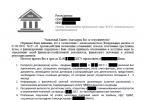Automotive medicine in service computer equipment: Another way to clean contacts
- Electronics for Beginners
A situation familiar to everyone. You are watching your favorite movie. At the most interesting place, the TV screen goes dark. Instead of a picture there is a message: “Check the signal cable”, “No signal”, “Check the power of the connected devices”, etc. Diagnosis in this case is simple:
- remove and insert the cable several times from the connectors at both ends;
- if it doesn’t work, try another cable;
- if another cable does not help, try to find out which end is the problem: connect the TV instead of the monitor to the PC; connect a monitor from a PC to a media player, etc.
Or maybe you won't have to?
What if it's ok?
Experience shows that 99% of such cases occur due to oxidation of contacts, not in the cable, but on the device itself. (This happens especially often when it’s already cold outside and the batteries haven’t been turned on yet - the houses are damp, and everything rusts especially quickly here). Yes, you once bought a high-quality wire with gold-plated connectors. But the monitor manufacturer may not have taken care of this. It is impossible to verify what material he used to make the contacts. Well, why don’t you pay 15 thousand for a new monitor?It offers simple and safe way cleaning absolutely any contacts. No cotton swabs, alcohol or cologne required. Everything is so simple that it’s awkward to even describe it.
- Turn the device with the connector up;
- Take a can of WD-40, insert the tube from the kit into the sprayer, place the tube close to the connector and press the head. You need to spray generously; you don’t have to be afraid if something gets inside the body. Nothing will happen to him;
- Immediately, while the lubricant liquid has not yet leaked out, take the mating part of the connector and insert/remove it several times in a row;
- We repeat paragraphs. 2-3 more times or two to be sure;
- We repeat paragraphs. 2-4 for the second device and for the second end of the cable;
If it works, don’t rush to put the equipment back in place. Turn the connector down, place a napkin and let the remaining “medicine” drain off.
How it works?
It is worth familiarizing yourself with this drug in more detail. Its composition is very simple: 50% white spirit, 15% mineral oil, carbon dioxide and certain “inert ingredients”. Nothing conductive, so no electrical hazard. Since the materials are flammable, you only need to make sure that there is no open fire nearby, nothing sparks or overheats. White spirit evaporates over time, and the oil forms a thin film, which subsequently slows down the oxidation of contacts. In addition, if dust gets into the connector, it will pick up moisture and also become conductive, which can lead to equipment failure. It is not always possible to remove these particles, but if they are oiled, the likelihood of a short circuit becomes much less likely.Isn't this dangerous?
I won’t say anything theoretically. But here are some experiences.Of course, I didn't come up with this myself. The first time I encountered such “electronics repair” was when the ignition suddenly failed in my car right on the highway. Call an electrician I know, advice: clean all contacts with a vane. After 15 minutes I move on.
Some time later (just before the start of the heating season), when I turn on the computer, I hear a disgusting squeak: memory problems. Mac Mini computer, Kingston memory, two 4 GB modules. Replacing the modules did not solve the problem, which means there is a problem with the motherboard, which is not cheap. Out of desperation, I decided to repeat my road experience: I splashed all the memory banks with Vedashka, installed/removed the modules several times. I turned on the machine - hurray, it worked! Naturally, immediately memtest all in single user mode - no problems. Since then it has been working flawlessly for a year.
The DVI connector on my Acer monitor stopped working at work. We temporarily connected via VGA and began to beg the authorities for a new monitor. Where there... And again this simple procedure solved all the problems.
And finally, the case with which this article opens. Samsung TV, BBK media player are connected to each other via HDMI. After 10 minutes we were already watching the movie.
conclusions
It turns out that a simple liquid that everyone is used to using to lubricate locks, bicycle chains, unscrew rusty nuts, and the like, can really extend the life of a complex expensive equipment. Of course, this can save money for owners of this very equipment. But what’s probably more important is how much pleasure it can bring to different owners of crazy hands.Important addition
Especially for novice electronics technicians - all manipulations with repeated removal/insertion of connectors should only be done by disconnecting both devices from the network. This also applies to those interfaces for which the standard allows for “hot” connection (for example, HDMI, USB): it’s one thing to plug it in once, another thing to pull it under current.And, of course, you don’t need to do this with devices that are under warranty - let the service center change everything for you free of charge. And “traces of foreign liquid” may serve as grounds for voiding the warranty.
What and how to clean contacts? Why, in general, do you need treatment, protection and lubrication of contacts? We will answer these and other questions in this short article.
It just so happens that the electrical system is a little neglected by car owners and is remembered only when either the next lamp has disappeared into the world of things that have gone out forever, or when, at the most inopportune moment, the starter does not respond to turning the ignition key.
It is also worth noting that most car fires occur due to faulty wiring and this happens instantly and unpredictably.
Therefore, the electrical system, like all other vehicle systems, requires regular maintenance.
Moreover, in our time this procedure is even more important than before. This is due to two reasons:
- cars have become literally crammed with electronics
- application of engine control systems
Well, the first reason is clear - the more wires, the more possible problems.
Why does the engine control system require increased attention?
This is due to the use of more low voltage in the wiring of the engine control system and the use of pulse signals.
The thing is that the higher the voltage, the lower the losses.
What do we get? Previously, only 12V or, on some, 24V was used in the electrical equipment of cars. And now the ECU operates mainly with a voltage of only 5V, and some sensors even with millivolts.
Ignition systems have become more powerful and are no longer controlled by the banal closing/opening of contacts, but by pulses of a certain duration set by the control unit.
All these low-current circuits must always have minimal and constant resistance, and they operate in constant temperature changes among the oily and dusty air under the hood. Condensation, puddles on the roads, constant vibration and corrosion inevitably make adjustments to the operation of the system.
I can say with confidence that the lion's share of all problems in the engine management system are related to the condition of the wiring.
And the weakest link in this chain is all kinds of contacts and connecting blocks.
How to clean and protect contacts?
All contacts sooner or later begin to corrode and become covered with nasty oxides, disrupting the operation of the system.
Therefore, the logical question arises - what and how to clean the contacts?
It is highly undesirable to clean contacts mechanically. Yes and in modern systems You can’t really get close to them. Traditional methods with an eraser, soda and the like do not give the desired result. And I consider the use of these ancient methods in the 21st century to be a fight against windmills.
As a radio mechanic, I have long been using modern chemistry to solve these problems. The same chemistry successfully broke into the automotive industry.
From practice, as for me, special attention deserve two of these.
Electrical contact lubricant
One of them is Contact 61.
And the second - Liqui Moly Electronic-Spray

This is a product for cleaning, lubricating and protecting all kinds of electrical contacts both low voltage and high

The price tag for these products is not exactly budget-friendly - 200ml costs 180-200 UAH. (about 8 American money). But it's worth it, believe me. Moreover, it will last you for a very, very long time.
One treatment is enough for at least a year, so spending one hour of time will give you confidence for the whole year that at the most crucial moment the contacts in the wiring will not let you down.
There is very little information about Liqui Moly Electronic-Spray on the Internet and other sources. Therefore, it is reasonable for many to have certain questions. One of the main ones is whether this remedy current and will there be any short circuits or leakage currents?
I have been using it for a long time and I can say that it is quite the opposite, it prevents stray currents, current leakage, heating of contacts, sparking, as it improves contact by filling microscopic cracks and roughness on the contacts.
I find a use for it wherever possible - car radio contacts, connectors for various sensors, limit switches, terminals battery, lamp contacts, adapter connectors, switches and switches, ignition system, etc. And this is only in a car! And in everyday life and repair of all kinds of equipment there are no less applications.
There was a case with a VAZ car. The man asked to see where his car’s turn signals had gone. He spent the whole day searching for the problem, replaced the steering column switches, but the problem was still not solved.
I just processed the button in five minutes alarm With this method I returned the flashing appearance to the car, even without replacing the button!
This spray is very easy to use. If the contacts are not very dirty, then we spray just a little on the contacts and connect the connector in place. If the contacts are dirty, then we also spray and wait until the violent reaction with the release of foam ends and connect everything back. If the contacts are very dirty, then spray, wait 10-15 minutes, remove the soggy dirt with a rag or compressed air and repeat the processing again. But the latter option is extremely rare and usually everything is cleared the first time.
There are products separately for cleaning, separately for lubrication and separately for protection and displacement of moisture. For example, the Contact series has a lot of them, tailored for a specific task. Kontakt U - rosin and flux cleaner, Kontakt S - contact cleaner from oxides and sulfur compounds, KONTAKT 60 - anti-corrosion protection of contacts, etc.
But KONTAKT 61 and Liqui Moly Electronic-Spray products are positioned as universal. So to speak, a budget option.
Their prices and properties are almost the same, so decide for yourself what to choose.
Attention! Be careful and always be aware of your actions. This article is about a universal contact protection product with a light cleansing effect! There are commercially available products specifically for cleaning contacts. Either through ignorance, or through negligence, the sellers do not warn that after using the contact cleaner, the contacts must be protected with a contact protectant!!! Otherwise, the contacts “turn green” and the treated surfaces are literally corroded. Including the board in the engine control unit. The vehicle becomes unusable and requires expensive repairs. There are quite a few such cases. Be careful! I mentioned this in the video at the end of this article.
How to clean contacts
First of all, I advise you to process the knock sensor connector and the connectors of other low-voltage sensors.
Attention! I do not recommend treating the oxygen sensor connector in this way! The reasons are outlined in the article about


Battery terminals.
It is worth noting that for terminals there is special lubricant in Liqui Moly “Batterie-Pol-Fett” tubes. But I only use spray.


Wiring harness connection block



And, of course, the connector of the ECU itself

You also need to pay attention to the temperature sensors - air and coolant, position sensor contacts camshafts, generator and starter. Well, definitely

Separately, I would like to dwell on the elements of the ignition system.
Processing contacts high voltage wires and ignition coils must be done one of the first. Both for prevention and if your car exhibits dips and twitching when sharp pressing gas pedals. The thing is that if there are problems in the ignition system, they will appear precisely when pedaling hard. This is due to the fact that the magnitude of the breakdown voltage is influenced by several factors, one of them being pressure.
On Idling the pressure in the cylinders is not high, and at the moment of opening throttle valve it increases sharply, increasing the breakdown voltage at the spark plug electrodes. And if there is a defect in the ignition system, then it will definitely show its influence at this very moment. We'll talk about this in one of the upcoming articles.
So, one of these defects is often a slightly increased contact resistance in the high-voltage wires and, especially, in the low-voltage connectors of the ignition coils. Moreover, a regular multimeter will not show this.
And very often cleaning and protecting contacts helps correct the situation. Business for three minutes, and the result is better side it will be 100%!
Moreover, if the car is more than three years old, then this procedure is simply mandatory.
First of all, we process the low-voltage contacts of the ignition coil. Remove the pad and apply spray

Next, lubricate the high-voltage contacts. To do this, it is not necessary to pour the cleaner into the coil terminals themselves, but simply apply the cleaner to the high-voltage wire, put it on the coil terminal and lightly twist it back and forth. It is also necessary to hold the wire with the contact upward so that the spray penetrates deeper - into the junction of the tip with the CV wire itself

We do the same thing at the other end of the line.

I advise you to do this procedure even on new wires and coils.
The same applies to other contacts and connectors. If you are installing a new sensor or connecting a new car radio, be sure to apply spray to the contacts. After all, the main task of these products is not only to clean, but also to create a microscopic protective film on contacts. This film protects the contact from moisture and air, preventing oxides and corrosion.
And don't forget about mounting blocks fuses and relays. We pulled out the relay, processed the connector and inserted it back. Nothing fancy

After these simple procedures, you will definitely notice that the car’s behavior has changed for the better! And the engine management system, electrical equipment and ignition system will work easier, which will result in an increased resource of the entire engine as a whole.
Here is a video about processing and protecting contacts
Peace and smooth roads to everyone!!!
Aerosol composition of combined action. Removes metal oxides and grease stains in a single process. Restores electrical conductivity and blocks leakage currents. Does not damage parts made of metals and plastics. - Cleans dirty contacts - Loosens and removes oxide salts - Reduces contact resistance - Does not contain silicone Using Kontaktreiniger allows you to quickly and easily clean contacts from oxides and contaminants, saves time and improves the quality of maintenance work on electrical equipment.
Application
Disconnect the contacts from the power source. Spray the product onto the contacts and, depending on the level of contamination, leave for about 5-10 minutes. Remove dirt with a cloth, brush or compressed air. If the product comes into contact with varnish or plastic surfaces, wipe them with a damp cloth. After cleaning, protect the contacts with Elektronik-Spray (Art. No. 3110) or LM 40 Multi-Funktions-Spray (Art. No. 3390). Note: Connect to power source 10 minutes after cleaning is completed.
I heard the contact out of the blue, if you can tell me a little more about the application
For liquids Kontakt
Kontakt 60
Purpose:
The drug ensures the regeneration of corroded and heavily contaminated contacts. Contacts treated with this preparation ensure reliable contact even with low pressing force.
Properties:
KONTAKT 60, by dissolving oxides and contaminants, effectively reduces the electrical resistance of contacts, increasing their durability. Reduces friction and has an anti-corrosion effect. Does not conduct electric current, counteracts the flow of “stray” currents. Chemically neutral towards popular plastics, metals, etc.
Application:
Disconnect the device being treated with the drug from the power source. Apply the drug to the contacts and wait about 15 minutes. Before this, it is recommended to remove residual oxides from their surfaces using KONTAKT WL and protect them with KONTAKT 61
Used for cleaning switches, connectors and sockets, microcircuit panels, fuse holders, etc.
100ml., 200ml., 400ml.
Color red
Flash point<0°C
Density at 20°C 0.76 g/cm3
Contact wl
Purpose:
CONTACT WL allows you to remove dirt, tarred oils and greases, rosin and other contaminants from the surfaces of components and parts. Does not react with popular construction materials.
Properties:
KONTAKT WL cleans contact surfaces exposed to KONTAKT 60, removes dissolved oxides and, most importantly, corrosion products from their surfaces. Provides long-term protection against re-occurrence of corroded areas.
Application:
Do not use for cleaning live devices. After cleaning, leave the devices for approximately 15 minutes to allow volatile solvents to evaporate. Suitable for relay contacts, slide switches, channel selectors, printed circuit boards, electric motors
Packaging in aerosol cans:
200ml., 400ml.
Color colorless
Flash point<0°C
Density at 20°C 0.77 g/cm3
Evaporation rate 10 (ether=1)
Contact 61
Purpose:
KONTAKT 61 is a specially developed cleaning, lubricating and anti-corrosion agent intended for the treatment and protection of new, non-oxidized electrical contacts and moving electromechanical parts or contacts that have been subjected to the cleaning action of KONTAKT 60 and KONTAKT WL.
Properties:
The drug forms a thin microscopic film on the surfaces being treated, preventing corrosion and at the same time ensuring high quality contact. The drug is neutral to other construction materials, eliminates the possibility of leakage currents, has anti-corrosion properties, and is a good lubricant. Provides excellent electrical conductivity, protects contact pads and sliders from abrasion and sintering. It has anti-friction properties, so the abrasive effect between the contact groups is greatly reduced, which in turn increases the contact surfaces accordingly.
Application:
Disconnect the mechanism from the power source. Attach the supplied tube to the spray head. Spray the surface to be cleaned. In case of heavy contamination, repeat the operation. Wipe off excess product along with dirt. It is used in production and during service work. Can act as a light lubricant for electromechanical drive devices in office equipment.
Packaging in aerosol cans:
200ml., 400ml.
Blue color
Density at 20°C 0.76 g/cm3
Temperature resistance up to 80°C
The modern chemical industry produces a variety of useful products for cleaning and protecting electrical contacts from corrosion and oxidation. But don’t discount recipes for such cleaners, as they can also come in handy when working with certain devices. This article describes several available chemical formulations for cleaning and protecting contacts.
Contact cleaners can be made relatively easily at home, and you don't need any fancy materials.
After any of the above cleaners, you need to move the contacts so that the composition gets into all parts of the surface being treated. You also need to wait about 15 minutes for the solvent to evaporate, after which you need to wipe the contacts with a cloth to remove dissolved dirt and excess solvent.
How to make liquid for cleaning electrical contacts recipe first:
You need to mix the substances in a glass jar following the proportions:
250 ml of concentrated aqueous ammonia,
750 ml of methanol (this substance is poisonous) or ethyl alcohol denatured with gasoline.
Store the mixture in a well-closed glass container.
How to make liquid for cleaning electrical contacts, recipe two:
It is necessary to dissolve 20 - 50 ml of Vaseline oil (medical) in 950 ml of extraction gasoline. Afterwards you need to mix thoroughly and pour into a bottle.
Composition for cleaning silver contacts:
If it is possible to remove the contacts and place them in the solution, then here is what you can use:
The contacts are first degreased by washing in trichlorethylene, ether or carbon tetrachloride. The degreased contacts are immersed in a bath with a 5% solution of potassium cyanide (BE VERY CAREFUL THIS IS A POISON!!!). It is recommended to move the parts while the contacts are immersed in the solution (no more than 1 minute). If during this time the dark layer on the silver contacts does not dissolve, you need to immerse the parts in a new solution (the old one is already saturated).
When the contamination disappears, the silver contact must be rinsed well in running water.
Please note that after such removal, silver is very susceptible to new oxidation! Therefore, your contacts must be placed in a composition of concentrated (25%) pure ammonia solution for no more than 3 minutes (stir the composition continuously). Then you need to rinse well with running water, or in ethyl alcohol, denatured gasoline or ether and dry well.
After such an operation, silver contacts will no longer oxidize under the influence of the external environment.
Contact protection recipe:
If you need to “preserve” electrical contacts for a long time, then do the following: In a porcelain cup, dissolve 10–30 g of stearic acid and 980 ml of trichlorethylene in a porcelain cup over low heat (instead of trichlorethylene, you can also use carbon tetrachloride or tetrachlorethylene).
It is necessary to let the solution settle and pour it into a bottle with a good stopper. This solution has a protective “preservative” effect. This solution must be applied to thoroughly cleaned, degreased and dry contacts in a uniform layer.
P.S.: I tried to clearly show and describe not tricky tips. I hope that at least something is useful to you. But this is not everything that can be imagined, so go ahead and study the site



